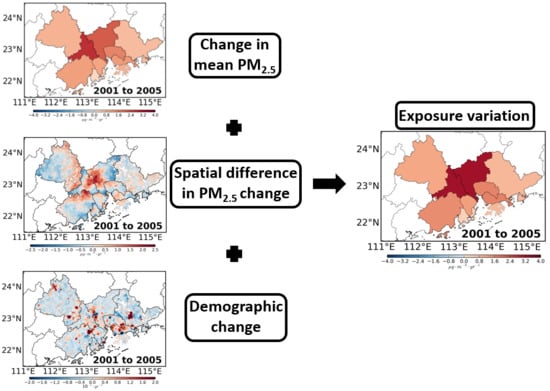Decomposing the Long-term Variation in Population Exposure to Outdoor PM2.5 in the Greater Bay Area of China Using Satellite Observations
Abstract
1. Introduction
2. Data
2.1. Population Density
2.2. Satellite-Derived PM2.5
3. Methodology
4. Results
4.1. 15-Year Mean Population Exposure
4.2. Decomposition of Exposure Variation
4.2.1. Effect of Changes in Mean PM2.5 Concentration
4.2.2. The Effect of Spatial Differences in PM2.5 Change
4.2.3. The Effect of Demographic Change
4.2.4. Long-Term Variation in PPCE
4.2.5. The Long-Term Variations in Population Exposure
5. Discussion
6. Conclusions
Author Contributions
Funding
Acknowledgments
Conflicts of Interest
Abbreviations
| GBA | Greater Bay Area |
| PRD | Pearl River Delta |
| FYP | Five-Year Plan |
| AOD | Aerosol optical depth |
| PM2.5 | Fine particulate matter |
| MODIS | Moderate Resolution Imaging Spectroradiometer |
| WHO | World Health Organization |
| IT-1 | Interim Target 1 |
| IT-2 | Interim Target 2 |
| IT-3 | Interim Target 3 |
| AQG | Air Quality Guideline |
| NAAQS | Chinese National Ambient Air Quality Standard |
| GZ | Guangzhou city |
| SZ | Shenzhen city |
| ZH | Zhuhai city |
| DG | Dongguan city |
| FS | Foshan city |
| ZS | Zhongshan city |
| ZQ | Zhaoqing city |
| JM | Jiangmen city |
| HZ | Huizhou city |
| HK | Hong Kong special administrative zone |
| MC | Macau special administrative zone |
| cρ | Population-weighted mean PM2.5 concentration |
| Spatial distribution of PM2.5 concentration | |
| Spatial distribution of population density | |
| c0 | Spatial average of PM2.5 concentration |
| ρ0 | Spatial average of population density |
| A | Area of the study region |
| Deviation of PM2.5 concentration from c0 | |
| Deviation of population density from ρ0 | |
| Relative deviation of population density from ρ0 | |
| Matrix of | |
| Matrix of | |
| PPCE (c1) | Pollution-population-coincidence–induced PM2.5 exposure |
Appendix: Exposure decomposition
References
- Bo, Y.; Guo, C.; Lin, C.; Chang, L.; Chan, T.C.; Huang, B.; Lee, K.P.; Tam, T.; Lau, A.K.H.; Lao, X.Q.; et al. Dynamic Changes in Long-Term Exposure to Ambient Particulate Matter and Incidence of Hypertension in Adults. Hypertension 2019, 74, 669–677. [Google Scholar] [CrossRef] [PubMed]
- Chan, T.C.; Zhang, Z.; Lin, B.C.; Lin, C.; Deng, H.B.; Chuang, Y.C.; Chan, J.W.M.; Jiang, W.K.; Tam, T.; Chang, L.; et al. Long-Term Exposure to Ambient Fine Particulate Matter and Chronic Kidney Disease: A Cohort Study. Environ. Health Perspect. 2018, 126, 107002. [Google Scholar] [CrossRef] [PubMed]
- Guo, C.; Zhang, Z.; Lau, A.K.H.; Lin, C.Q.; Chuang, Y.C.; Chan, J.; Jiang, W.K.; Tam, T.; Yeoh, E.K.; Chan, T.C.; et al. Effect of long-term exposure to fine particulate matter on lung function decline and risk of chronic obstructive pulmonary disease in Taiwan: A longitudinal, cohort study. Lancet Planet. Health 2018, 2, e114–e125. [Google Scholar] [CrossRef]
- Lao, X.Q.; Guo, C.; Chang, L.; Bo, Y.; Zhang, Z.; Chuang, Y.C.; Jiang, W.K.; Lin, C.; Tam, T.; Lau, A.K.H.; et al. Long-term exposure to ambient fine particulate matter (PM2.5) and incident type 2 diabetes: A longitudinal cohort study. Diabetologia 2019, 62, 759–769. [Google Scholar] [CrossRef] [PubMed]
- Zhang, Z.; Chan, T.C.; Guo, C.; Chang, L.; Lin, C.; Chuang, Y.C.; Jiang, W.K.; Ho, K.F.; Tam, T.; Woo, K.S.; et al. Long-term exposure to ambient particulate matter (PM2.5) is associated with platelet counts in adults. Environ. Pollut. 2018, 240, 432–439. [Google Scholar] [CrossRef] [PubMed]
- Apte, J.S.; Marshall, J.D.; Cohen, A.J.; Brauer, M. Addressing Global Mortality from Ambient PM2.5. Environ. Sci. Technol. 2015, 49, 8057–8066. [Google Scholar] [CrossRef] [PubMed]
- Zhong, L.; Louie, P.K.K.; Zheng, J.; Yuan, Z.; Yue, D.; Ho, J.W.K.; Lau, A.K.H. Science–policy interplay: Air quality management in the Pearl River Delta region and Hong Kong. Atmos. Environ. 2013, 76, 3–10. [Google Scholar] [CrossRef]
- Aunan, K.; Ma, Q.; Lund, M.T.; Wang, S. Population-weighted exposure to PM2.5 pollution in China: An integrated approach. Environ. Int. 2018, 120, 111–120. [Google Scholar] [CrossRef]
- Brauer, M.; Amann, M.; Burnett, R.T.; Cohen, A.; Dentener, F.; Ezzati, M.; Henderson, S.B.; Krzyzanowski, M.; Martin, R.V.; Van Dingenen, R.; et al. Exposure Assessment for Estimation of the Global Burden of Disease Attributable to Outdoor Air Pollution. Environ. Sci. Technol. 2012, 46, 652–660. [Google Scholar] [CrossRef]
- David, L.M.; Ravishankara, A.R.; Kodros, J.K.; Pierce, J.R.; Venkataraman, C.; Sadavarte, P. Premature Mortality Due to PM2.5 Over India: Effect of Atmospheric Transport and Anthropogenic Emissions. GeoHealth 2019, 3, 2–10. [Google Scholar] [CrossRef]
- Van Donkelaar, A.; Martin, R.V.; Brauer, M.; Boys, B.L. Use of satellite observations for long-term exposure assessment of global concentrations of fine particulate matter. Environ. Health Perspect. 2015, 123, 135–143. [Google Scholar] [CrossRef] [PubMed]
- Gui, K.; Che, H.; Wang, Y.; Wang, H.; Zhang, L.; Zhao, H.; Zheng, Y.; Sun, T.; Zhang, X. Satellite-derived PM2.5 concentration trends over Eastern China from 1998 to 2016: Relationships to emissions and meteorological parameters. Environ. Pollut. 2019, 247, 1125–1133. [Google Scholar] [CrossRef] [PubMed]
- Li, J.; Zhu, Y.; Kelly, J.T.; Jang, C.J.; Wang, S.; Hanna, A.; Xing, J.; Lin, C.J.; Long, S.; Yu, L. Health benefit assessment of PM2.5 reduction in Pearl River Delta region of China using a model-monitor data fusion approach. J. Environ. Manag. 2019, 233, 489–498. [Google Scholar] [CrossRef] [PubMed]
- Xue, T.; Zheng, Y.; Tong, D.; Zheng, B.; Li, X.; Zhu, T.; Zhang, Q. Spatiotemporal continuous estimates of PM2.5 concentrations in China, 2000–2016: A machine learning method with inputs from satellites, chemical transport model, and ground observations. Environ. Int. 2019, 123, 345–357. [Google Scholar] [CrossRef]
- Zheng, H.; Zhao, B.; Wang, S.; Wang, T.; Ding, D.; Chang, X.; Liu, K.; Xing, J.; Dong, Z.; Aunan, K.; et al. Transition in source contributions of PM2.5 exposure and associated premature mortality in China during 2005–2015. Environ. Int. 2019, 132, 105111. [Google Scholar] [CrossRef]
- Burnett, R.; Chen, H.; Szyszkowicz, M.; Fann, N.; Hubbell, B.; Pope, C.A.; Apte, J.S.; Brauer, M.; Cohen, A.; Weichenthal, S.; et al. Global estimates of mortality associated with long-term exposure to outdoor fine particulate matter. Proc. Natl. Acad. Sci. USA 2018, 115, 9592–9597. [Google Scholar] [CrossRef]
- Lin, C.Q.; Li, Y.; Lau, A.K.H.; Deng, X.J.; Tse, K.T.; Fung, J.C.H.; Li, C.C.; Li, Z.Y.; Lu, X.C.; Zhang, X.G.; et al. Estimation of long-term population exposure to PM2.5 for dense urban areas using 1-km MODIS data. Remote Sens. Environ. 2016, 179, 13–22. [Google Scholar] [CrossRef]
- Lu, Q.; Zheng, J.; Ye, S.; Shen, X.; Yuan, Z.; Yin, S. Emission trends and source characteristics of SO2, NOx, PM10 and VOCs in the Pearl River Delta region from 2000 to 2009. Atmos. Environ. 2013, 76, 11–20. [Google Scholar] [CrossRef]
- Ma, Z.; Hu, X.; Sayer, A.M.; Levy, R.; Zhang, Q.; Xue, Y.; Tong, S.; Bi, J.; Huang, L.; Liu, Y. Satellite-Based Spatiotemporal Trends in PM2.5 Concentrations: China, 2004–2013. Environ. Health Perspect. 2016, 124, 184–192. [Google Scholar] [CrossRef]
- Lin, C.Q.; Li, Y.; Lau, A.K.H.; Li, C.C.; Fung, J.C.H. 15-Year PM2.5 Trends in the Pearl River Delta Region and Hong Kong from Satellite Observation. Aerosol Air Qual. Res. 2018, 18, 2355–2362. [Google Scholar] [CrossRef]
- Lin, C.; Lau, A.K.H.; Lu, X.; Fung, J.C.H.; Li, Z.; Li, C.; Wong, A.H.S. Assessing Effect of Targeting Reduction of PM2.5 Concentration on Human Exposure and Health Burden in Hong Kong Using Satellite Observation. Remote Sens. 2018, 10, 2064. [Google Scholar] [CrossRef]
- Lin, C.Q.; Lau, A.K.H.; Li, Y.; Fung, J.C.H.; Li, C.C.; Lu, X.C.; Li, Z.Y. Difference in PM2.5 variations between urban and rural areas over eastern China from 2001 to 2015. Atmosphere 2018, 9, 312. [Google Scholar] [CrossRef]
- Wang, J.; Zhao, B.; Wang, S.; Yang, F.; Xing, J.; Morawska, L.; Ding, A.; Kulmala, M.; Kerminen, V.M.; Kujansuu, J.; et al. Particulate matter pollution over China and the effects of control policies. Sci. Total Environ. 2017, 584–585, 426–447. [Google Scholar] [CrossRef]
- Lin, C.; Lau, A.K.H.; Fung, J.C.H.; Lao, X.Q.; Li, Y.; Li, C. Assessing the Effect of the Long-Term Variations in Aerosol Characteristics on Satellite Remote Sensing of PM2.5 Using an Observation-Based Model. Environ. Sci. Technol. 2019, 53, 2990–3000. [Google Scholar] [CrossRef] [PubMed]
- Lin, C.Q.; Li, C.C.; Lau, A.K.H.; Yuan, Z.B.; Lu, X.C.; Tse, K.T.; Fung, J.C.H.; Li, Y.; Yao, T.; Su, L.; et al. Assessment of satellite-based aerosol optical depth using continuous lidar observation. Atmos. Environ. 2016, 140, 273–282. [Google Scholar] [CrossRef]
- Li, Y.; Lin, C.; Lau, A.K.H.; Liao, C.; Zhang, Y.; Zeng, W.; Li, C.; Fung, J.C.H.; Tse, T.K.T. Assessing Long-Term Trend of Particulate Matter Pollution in the Pearl River Delta Region Using Satellite Remote Sensing. Environ. Sci. Technol. 2015, 49, 11670–11678. [Google Scholar] [CrossRef]
- Li, C.; Lau, A.K.H.; Mao, J.; Chu, D.A. Retrieval, validation, and application of the 1-km aerosol optical depth from MODIS measurements over Hong Kong. IEEE Trans. Geosci. Remote Sens. 2005, 43, 2650–2658. [Google Scholar]
- Lin, C.Q.; Li, Y.; Yuan, Z.B.; Lau, A.K.H.; Li, C.C.; Fung, J.C.H. Using satellite remote sensing data to estimate the high-resolution distribution of ground-level PM2.5. Remote Sens. Environ. 2015, 156, 117–128. [Google Scholar] [CrossRef]
- Lin, C.Q.; Liu, G.; Lau, A.K.H.; Li, Y.; Li, C.C.; Fung, J.C.H.; Lao, X.Q. High-resolution satellite remote sensing of provincial PM2.5 trends in China from 2001 to 2015. Atmos. Environ. 2018, 180, 110–116. [Google Scholar] [CrossRef]
- Geng, G.; Zhang, Q.; Martin, R.V.; van Donkelaar, A.; Huo, H.; Che, H.; Lin, J.; He, K. Estimating long-term PM2.5 concentrations in China using satellite-based aerosol optical depth and a chemical transport model. Remote Sens. Environ. 2015, 166, 262–270. [Google Scholar] [CrossRef]
- Peng, J.; Chen, S.; Lü, H.; Liu, Y.; Wu, J. Spatiotemporal patterns of remotely sensed PM2.5 concentration in China from 1999 to 2011. Remote Sens. Environ. 2016, 174, 109–121. [Google Scholar] [CrossRef]
- Van Donkelaar, A.; Martin, R.V.; Brauer, M.; Kahn, R.; Levy, R.; Verduzco, C.; Villeneuve, P.J. Global estimates of ambient fine particulate matter concentrations from satellite-based aerosol optical depth: Development and application. Environ. Health Perspect. 2010, 118, 847–855. [Google Scholar] [CrossRef] [PubMed]
- OECD. Redefining “Urban”: A New Way to Measure Metropolitan Areas; OECD Publishing: Paris, France, 2012. [Google Scholar]
- Li, Z.; Wen, Q.; Zhang, R. Sources, health effects and control strategies of indoor fine particulate matter (PM2.5): A review. Sci. Total Environ. 2017, 586, 610–622. [Google Scholar] [CrossRef] [PubMed]
- Li, Z.; Che, W.; Lau, A.K.H.; Fung, J.C.H.; Lin, C.; Lu, X. A feasible experimental framework for field calibration of portable light-scattering aerosol monitors: Case of TSI DustTrak. Environ. Pollut. 2019, 255, 113136. [Google Scholar] [CrossRef] [PubMed]
- Li, Z.; Che, W.; Frey, H.C.; Lau, A.K.H.; Lin, C. Characterization of PM2.5 exposure concentration in transport microenvironments using portable monitors. Environ. Pollut. 2017, 228, 433–442. [Google Scholar] [CrossRef]
- Li, Y.; Lau, A.K.H.; Fung, J.C.H.; Ma, H.; Tse, Y. Systematic evaluation of ozone control policies using an Ozone Source Apportionment method. Atmos. Environ. 2013, 76, 136–146. [Google Scholar] [CrossRef]
- Lu, X.; Yao, T.; Li, Y.; Fung, J.C.H.; Lau, A.K.H. Source apportionment and health effect of NOx over the Pearl River Delta region in southern China. Environ. Pollut. 2016, 212, 135–146. [Google Scholar] [CrossRef]
- Wang, X.; Liu, H.; Pang, J.; Carmichael, G.; He, K.; Fan, Q.; Zhong, L.; Wu, Z.; Zhang, J. Reductions in sulfur pollution in the Pearl River Delta region, China: Assessing the effectiveness of emission controls. Atmos. Environ. 2013, 76, 113–124. [Google Scholar] [CrossRef]
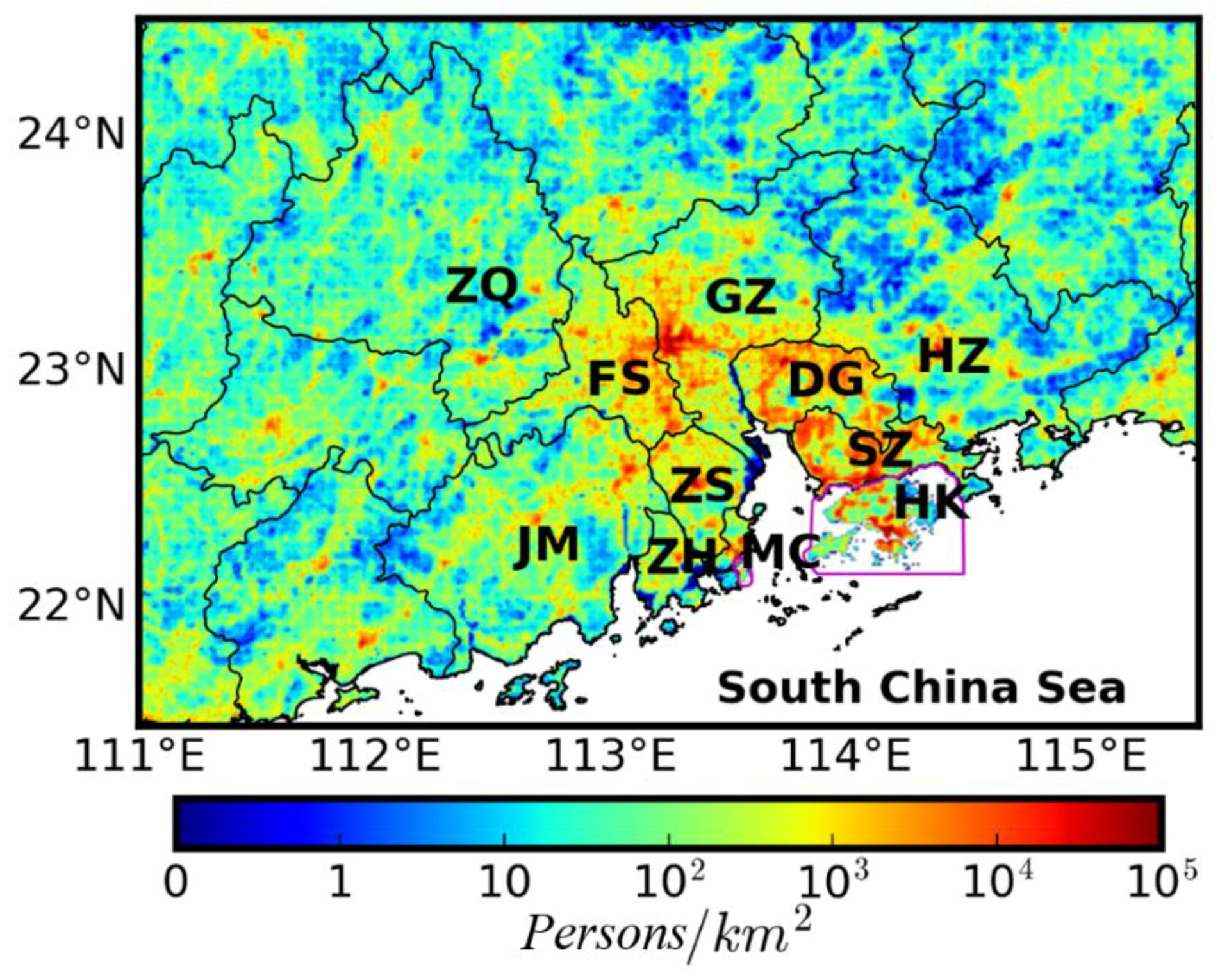
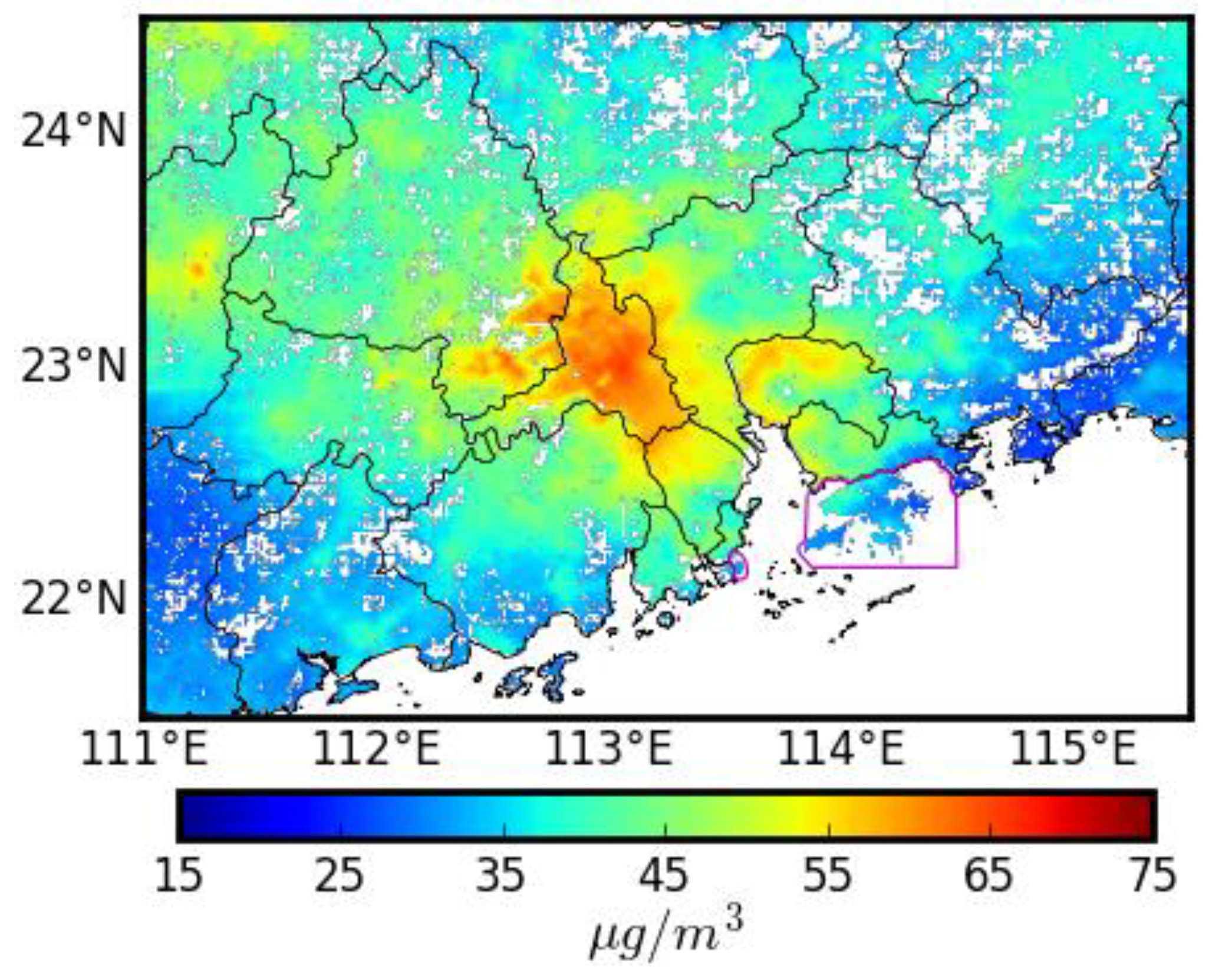
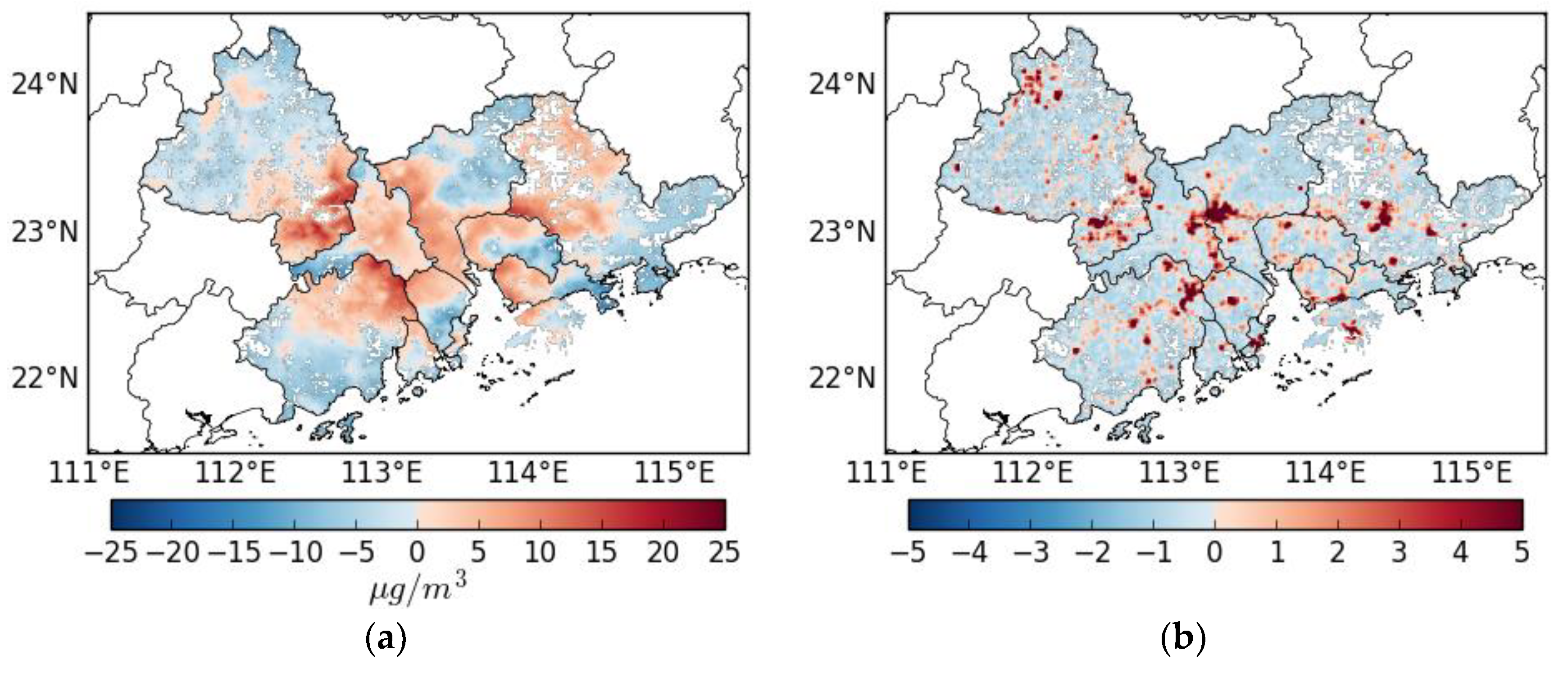
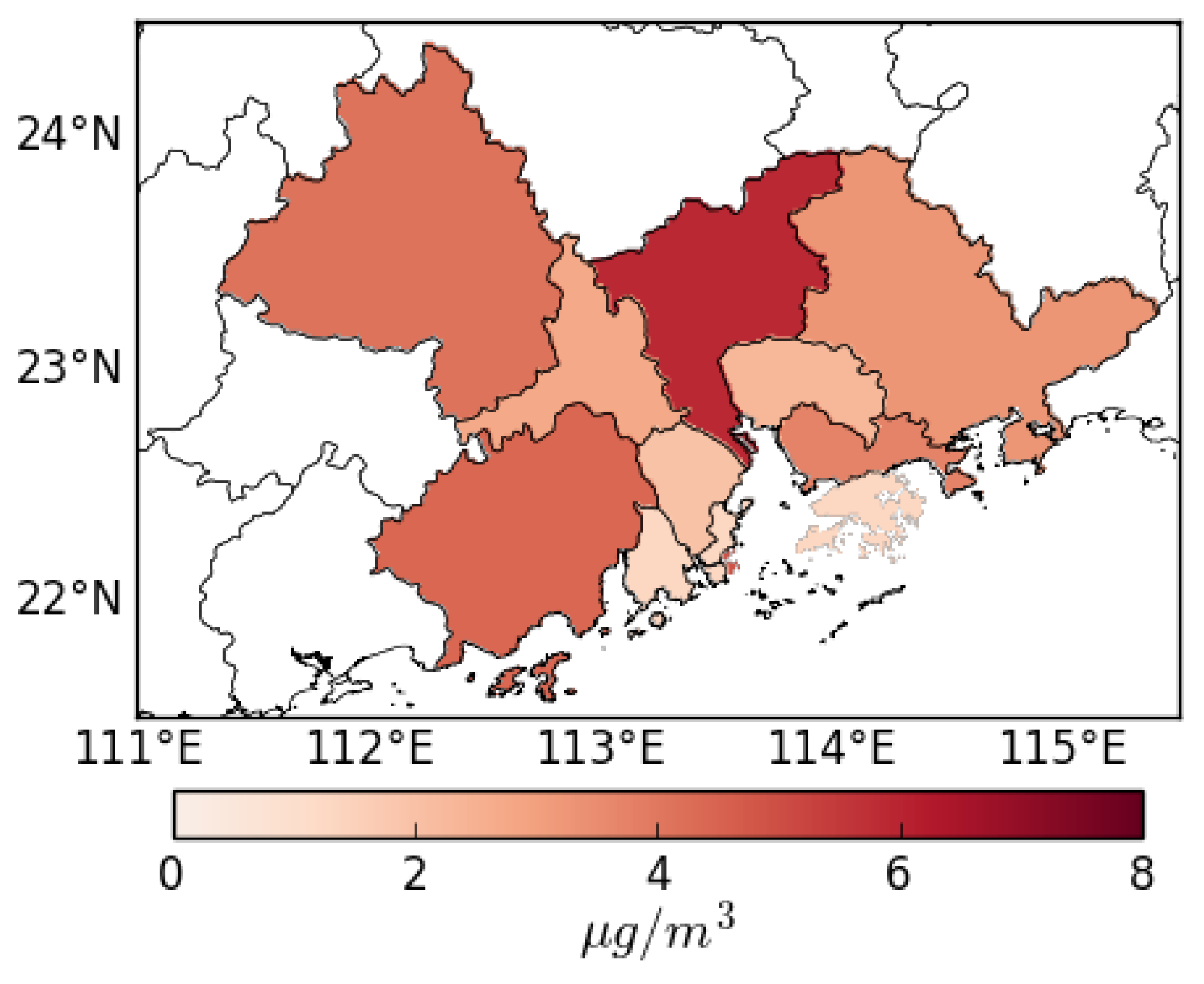
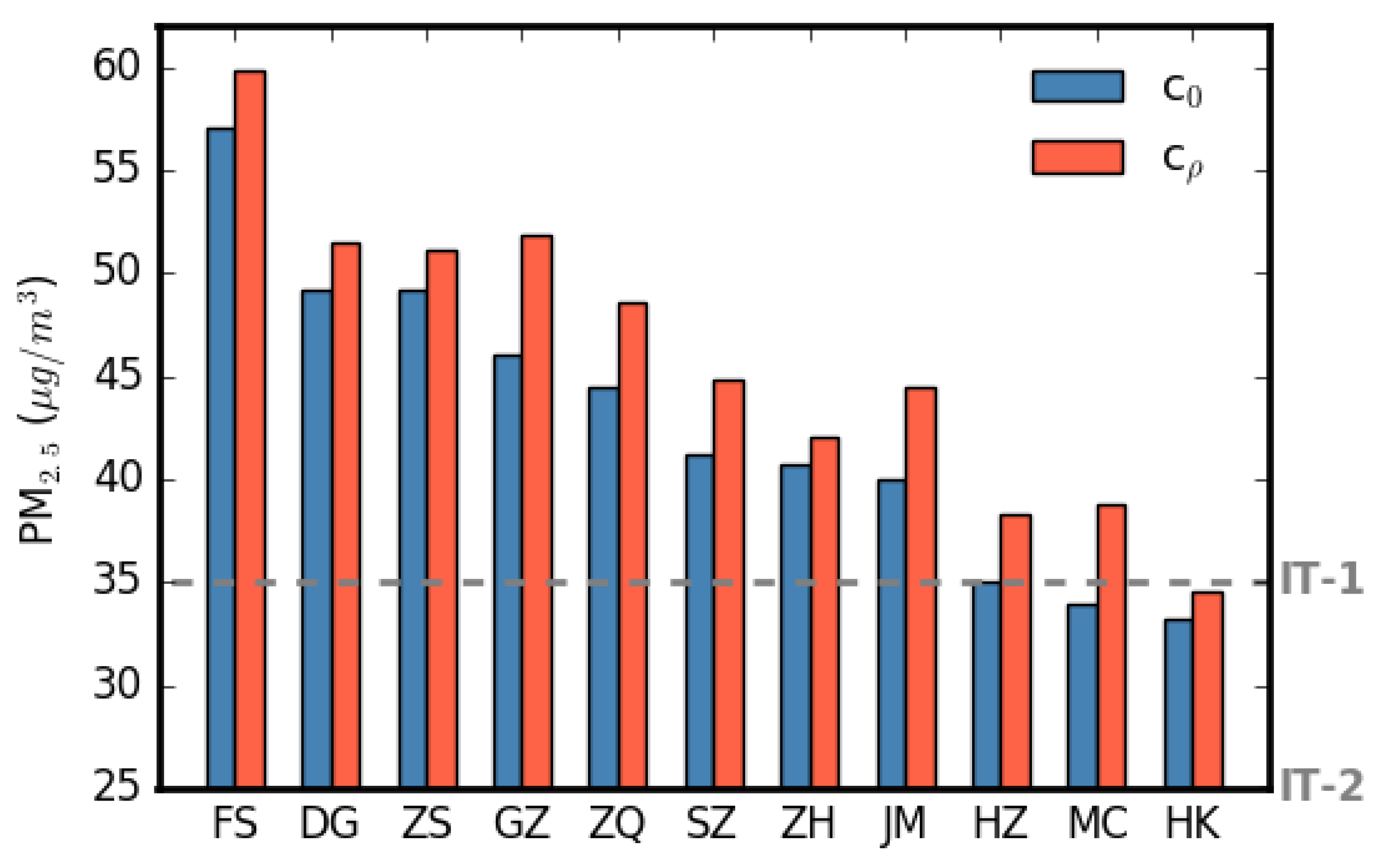

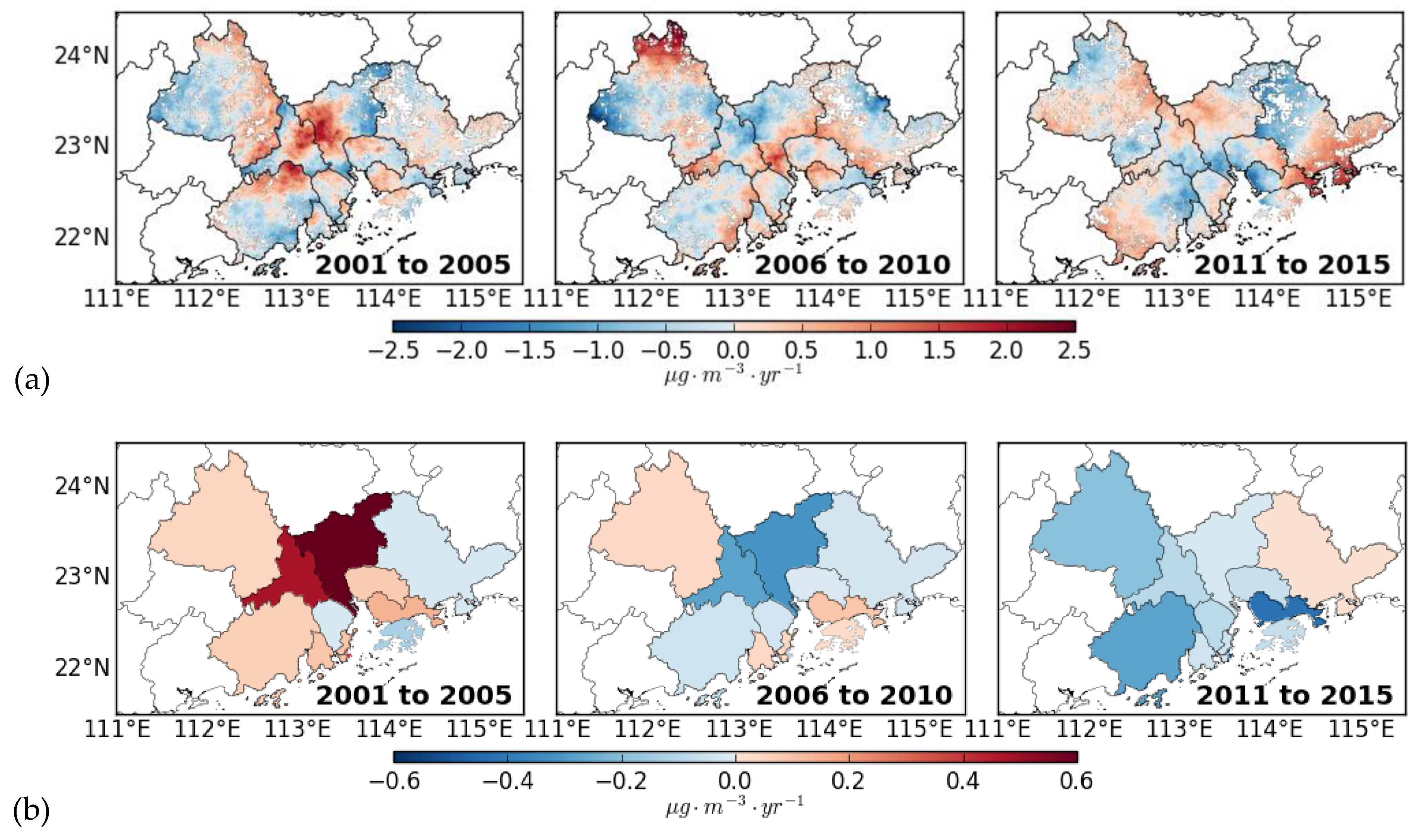
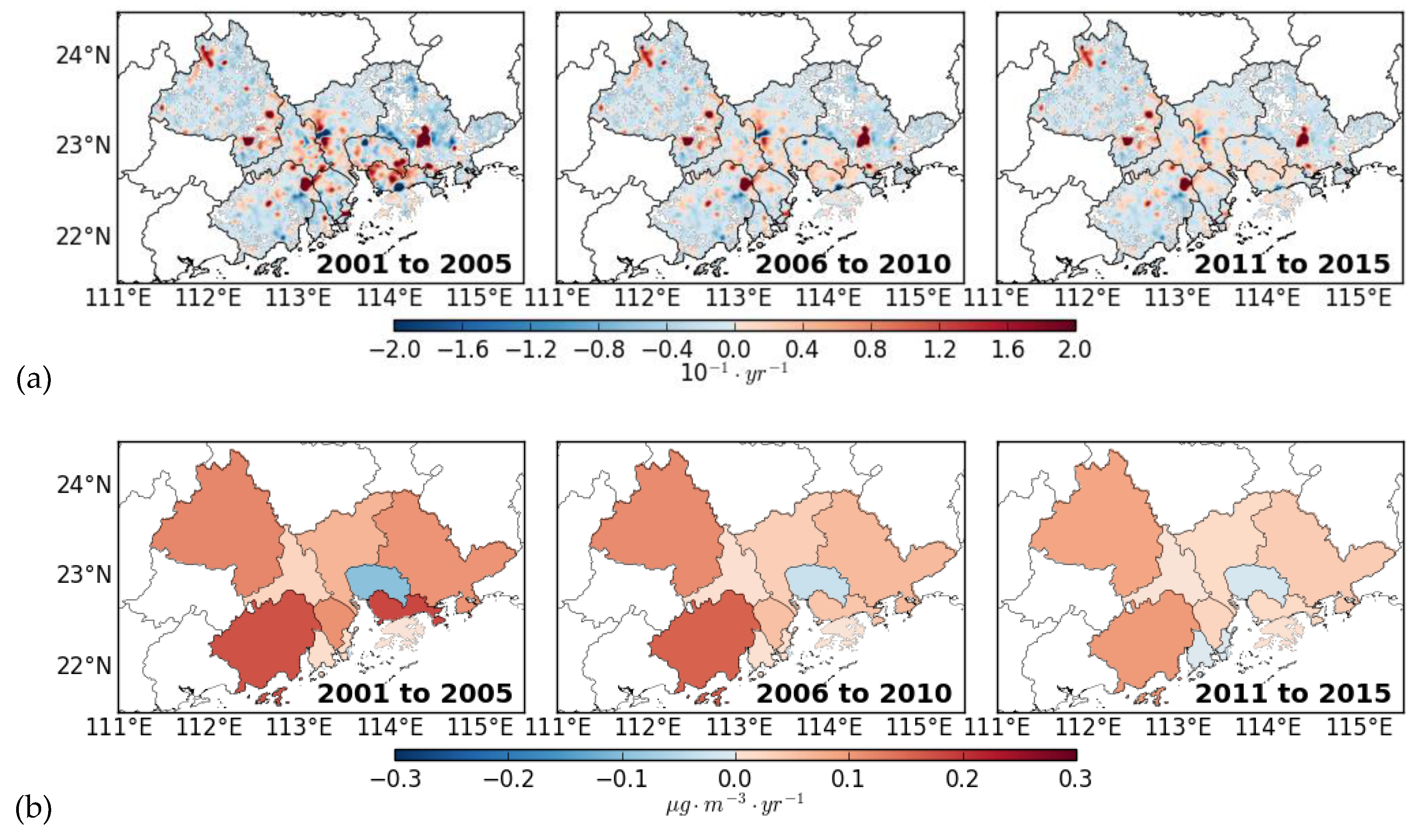
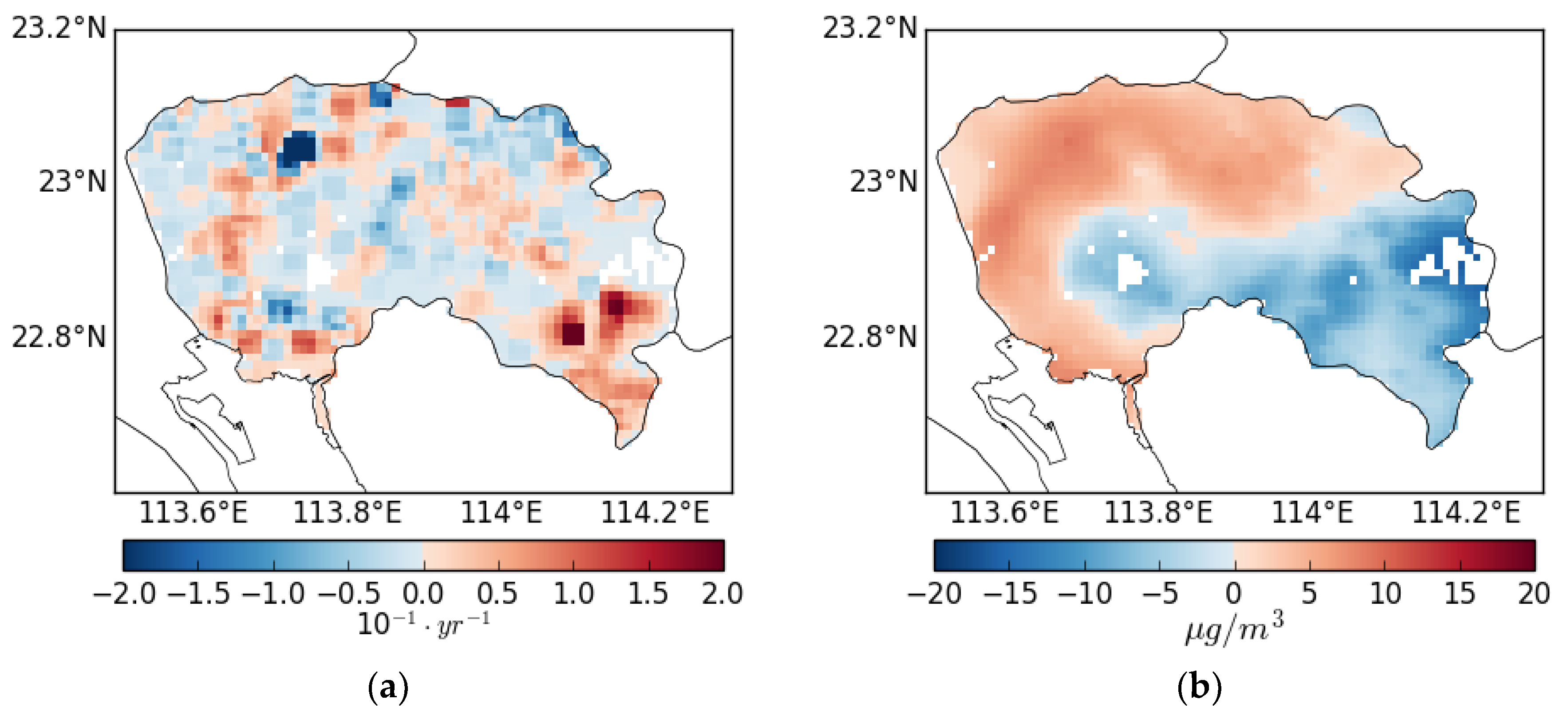
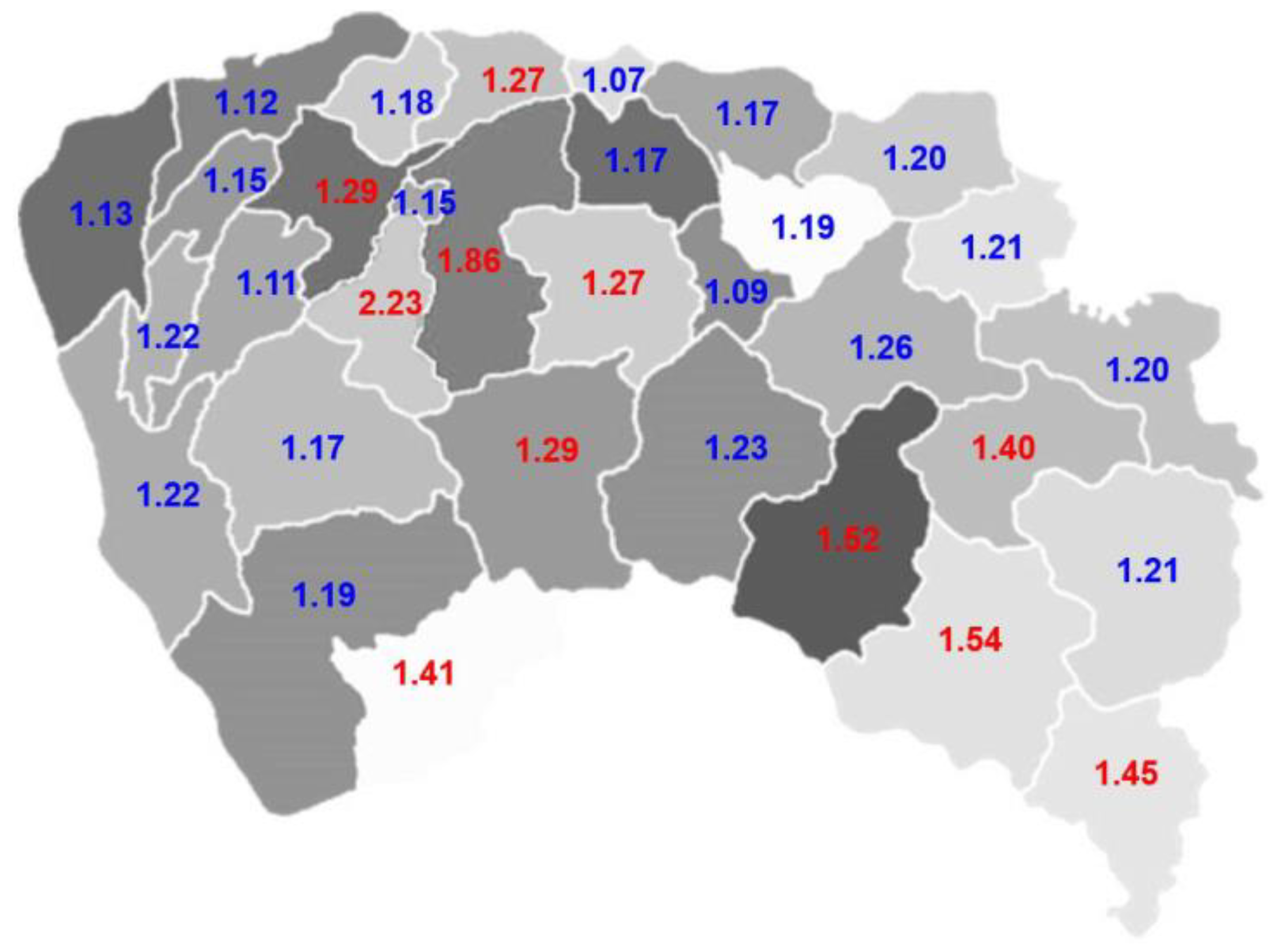
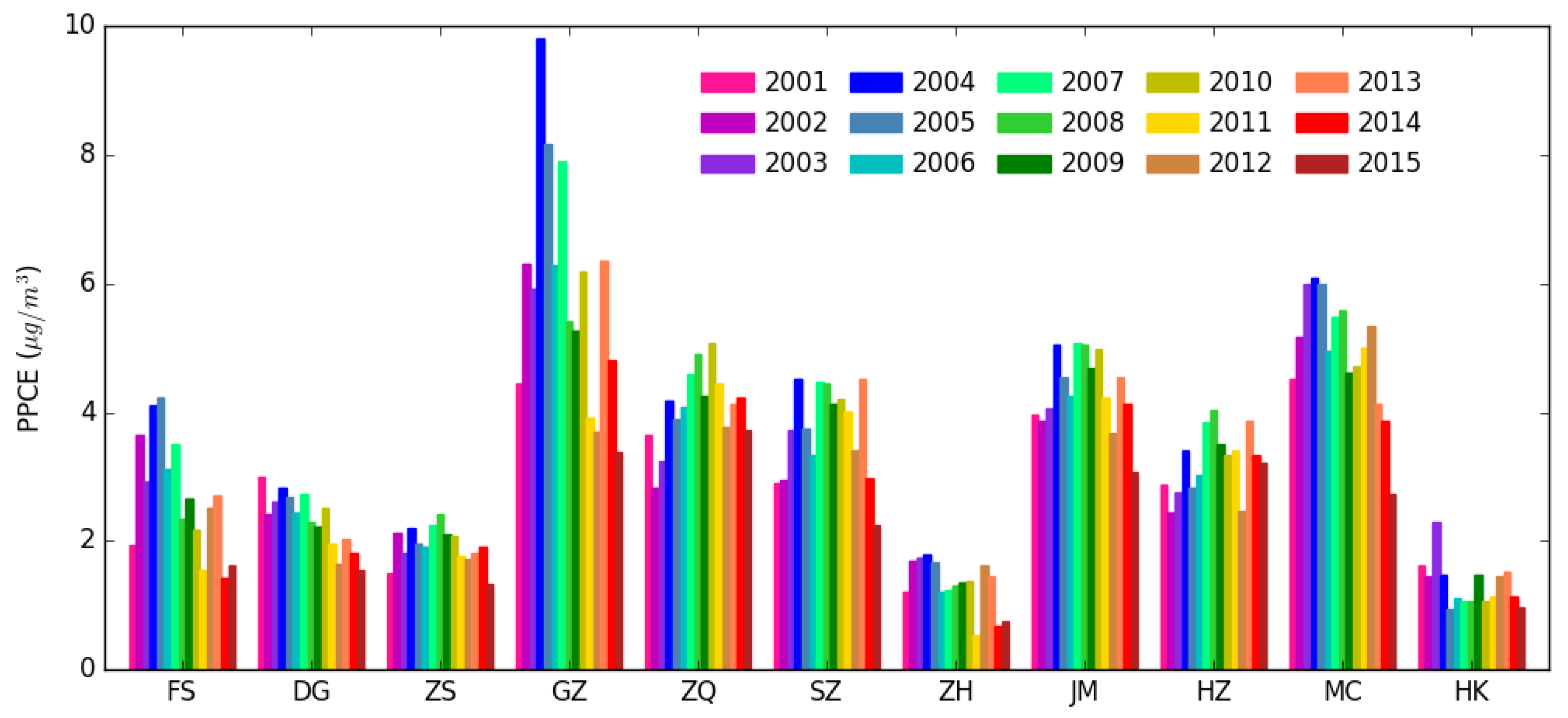
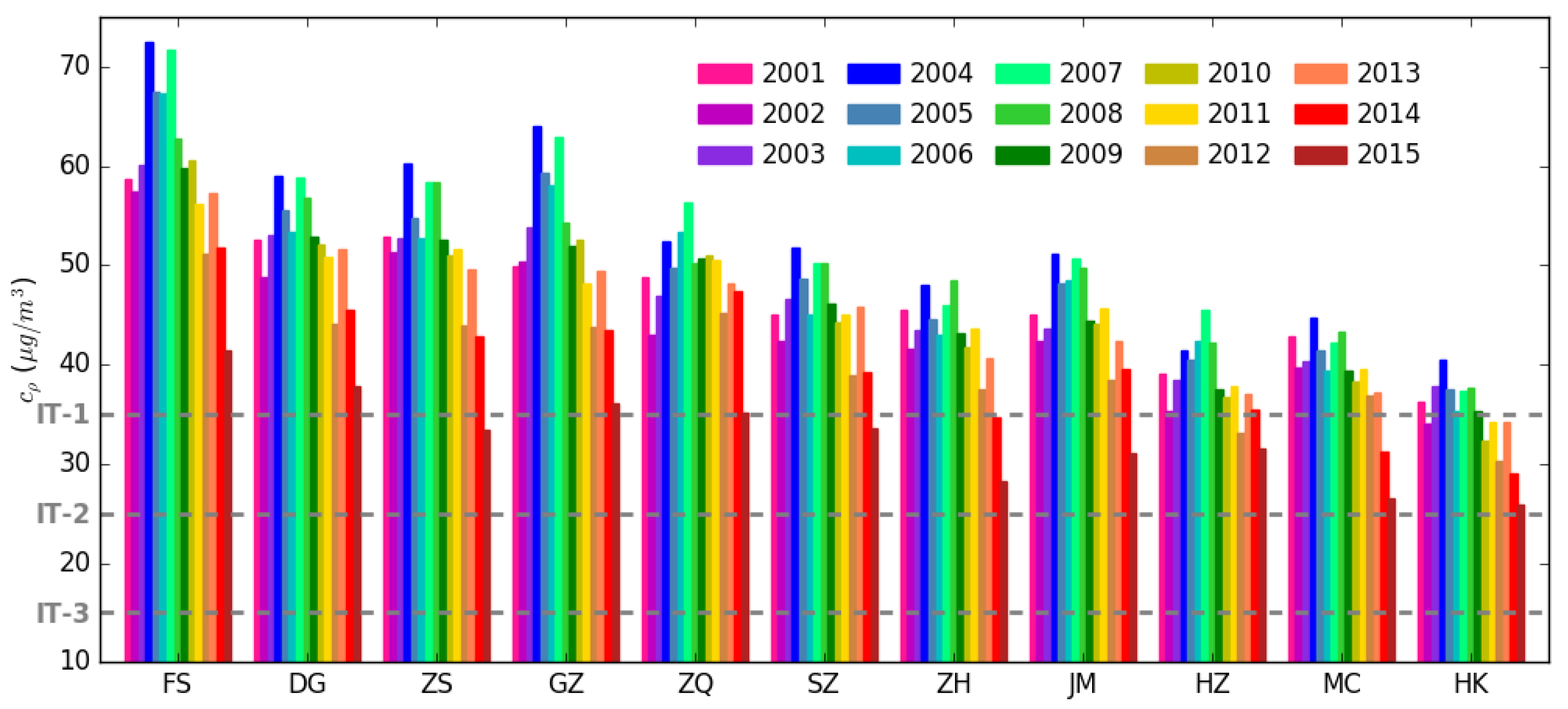

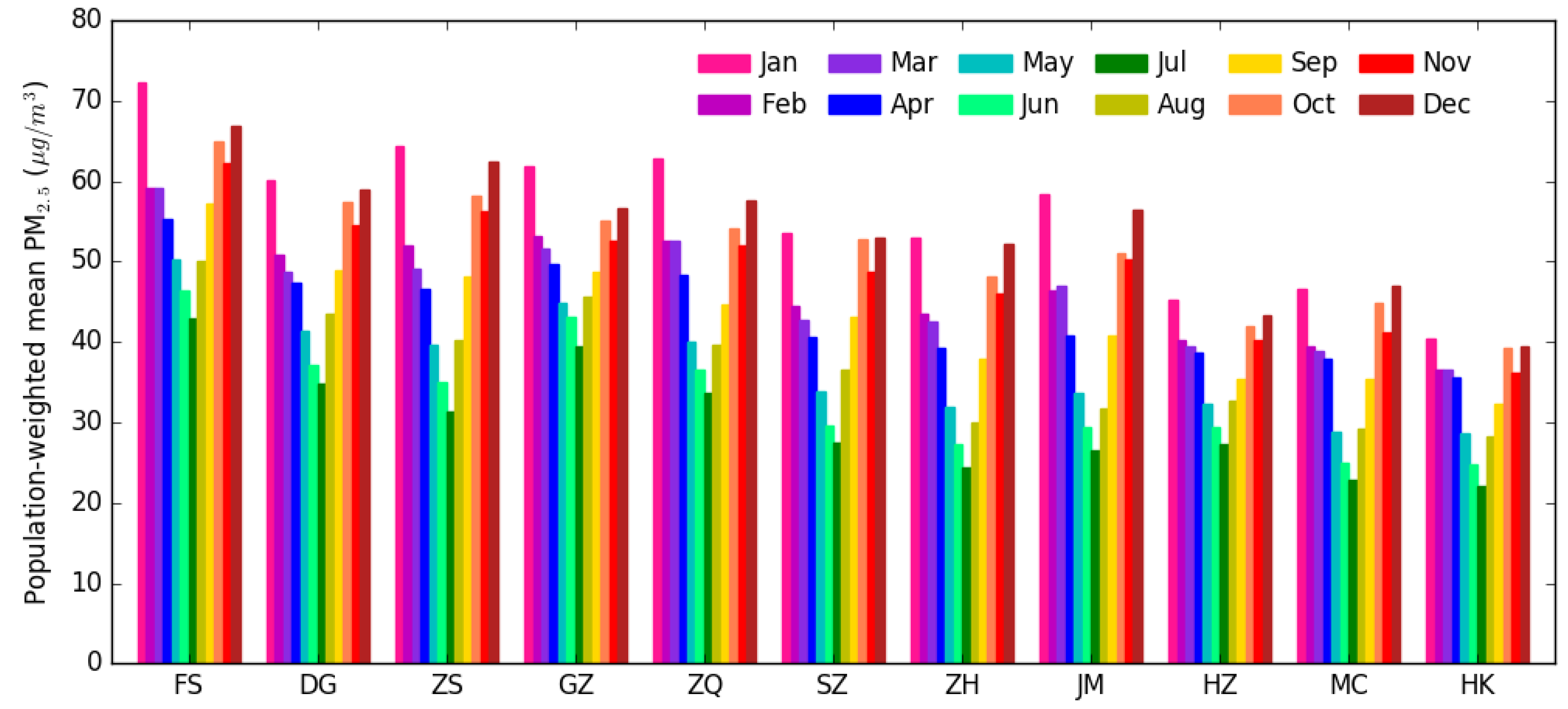
© 2019 by the authors. Licensee MDPI, Basel, Switzerland. This article is an open access article distributed under the terms and conditions of the Creative Commons Attribution (CC BY) license (http://creativecommons.org/licenses/by/4.0/).
Share and Cite
Lin, C.; Lau, A.K.H.; Fung, J.C.H.; He, Q.; Ma, J.; Lu, X.; Li, Z.; Li, C.; Zuo, R.; Wong, A.H.S. Decomposing the Long-term Variation in Population Exposure to Outdoor PM2.5 in the Greater Bay Area of China Using Satellite Observations. Remote Sens. 2019, 11, 2646. https://doi.org/10.3390/rs11222646
Lin C, Lau AKH, Fung JCH, He Q, Ma J, Lu X, Li Z, Li C, Zuo R, Wong AHS. Decomposing the Long-term Variation in Population Exposure to Outdoor PM2.5 in the Greater Bay Area of China Using Satellite Observations. Remote Sensing. 2019; 11(22):2646. https://doi.org/10.3390/rs11222646
Chicago/Turabian StyleLin, Changqing, Alexis K. H. Lau, Jimmy C. H. Fung, Qianshan He, Jun Ma, Xingcheng Lu, Zhiyuan Li, Chengcai Li, Renguang Zuo, and Andromeda H. S. Wong. 2019. "Decomposing the Long-term Variation in Population Exposure to Outdoor PM2.5 in the Greater Bay Area of China Using Satellite Observations" Remote Sensing 11, no. 22: 2646. https://doi.org/10.3390/rs11222646
APA StyleLin, C., Lau, A. K. H., Fung, J. C. H., He, Q., Ma, J., Lu, X., Li, Z., Li, C., Zuo, R., & Wong, A. H. S. (2019). Decomposing the Long-term Variation in Population Exposure to Outdoor PM2.5 in the Greater Bay Area of China Using Satellite Observations. Remote Sensing, 11(22), 2646. https://doi.org/10.3390/rs11222646









